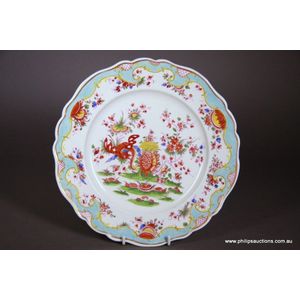Crown Derby 'Derby Posies' Dinner Set for Six
You must be a subscriber, and be logged in to view price and dealer details.
Subscribe Now to view actual auction price for this item
When you subscribe, you have the option of setting the currency in which to display prices to $Au, $US, $NZ or Stg.
- Coffee Can - A coffee can is a cup for holding coffee, but of a cylindrical shape rather than the waisted shape of traditional cups. They were in use at the end of the 18th century and in the early 19th century.
- Gilding - Gilding is a method of ornamentation whereby a thin sheet of gold metal is applied to items made of wood, leather, ceramics, glass and silver for decorative purposes.
For furniture including mirrors, the sheet of gold is usually applied over a coating of gesso. Gesso is a mixture of plaster of Paris and gypsum mixed with water and then applied to the carved wooden frames of mirrors and picture frames as a base for applying the gold leaf. After numerous coats of gesso have been applied, allowed to dry and then sanded a coat of "bole", a usually red coloured mixture of clay and glue is brushed on and allowed to dry, after which the gold leaf is applied. Over time parts of the gilding will rub off so the base colour can be seen. In water gilding, this was generally a blue colour, while in oil gilding, the under layer was often yellow. In Victorian times, gilders frequently used red as a pigment beneath the gold leaf.
Metal was often gilded by a process known as fire gilding. Gold mixed with mercury was applied and heated, causing the mercury to evaporate, the long-term effect of which was to kill or disable the craftsman or woman from mercury poisoning. The pursuit of beauty has claimed many victims, not the least of which were the artists who made those pieces so highly sought after today.
This item has been included into following indexes:
-
Royal Crown Derby (England), item types
- dinner sets 50
- plates and platters 164
- Royal Crown Derby (England), patterns - Posies pattern 84
Visually similar items

A twenty piece Royal Crown Derby dinner service, 1965 and 1966, in 'Derby Posies' pattern, a six place setting, comprising, dinner, entree and dessert bowls, with a pair of salt and pepper shakers, in a sprigged floral pattern upon white; backstamps and da

A Chamberlain Worcester 'Jabberwocky' plate, circa 1816-1820, pattern 1713, the scallop edged plate with a rococo inspired aqua border with cellular patterns enclosing a fantastic bird in a highly ornamental stylised garden in iron red, mid green and yello

A Royal Crown Derby 'Posies' part dinner and tea service. Variously dated, sixty pieces. The finely lobed and scallop edged service decorated with loose bunches and sprigs of coloured Summer flowers comprising: six dinner and ten entree plates, six soup bo

A ninety six piece Limoges porcelain dinner service, circa 1960s, the service in a fancy bird and floral design on white, comprising twelve cups and associated saucers, twenty three dinner plates, twenty four side plates, twelve shallow soup or dessert bow
